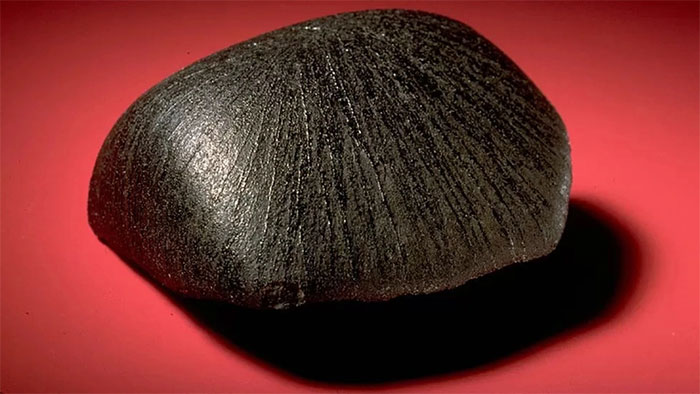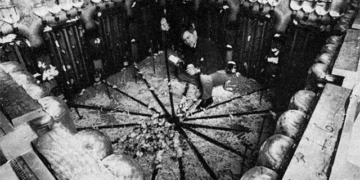Discovery of a toxin causing vomiting in humans and pigs in the primordial meteorite named Lafayette helps researchers uncover its origins.

The Lafayette meteorite has a smooth surface. (Photo: Purdue University).
The Lafayette meteorite was ejected from the surface of Mars millions of years ago and is currently housed at Purdue University in Indiana. In 1931, this unusually smooth black stone was identified as a primordial meteorite. However, how Purdue University acquired the stone and who brought it to the school has remained a mystery for the past 90 years. In a study published on October 19 in the journal Astrobiology, scientists analyzed the meteorite and discovered a strange compound that could help unravel the mystery.
Meteorite collector Harvey Nininger reported on Lafayette in 1935. He stated that a Black student at Purdue witnessed the meteorite landing in a pond where he was fishing and collected the stone, later donating it to the university. However, evidence supporting this story is scarce.
In 2019, a research team led by Aine O’Brien, a planetary scientist at the University of Glasgow in Scotland, was determined to solve the mystery. What makes Lafayette valuable is its intact condition, indicating that it was quickly recovered after landing. When meteorites are left outdoors for extended periods, their outer layers become eroded and contaminated, diminishing their research value.

Dr. Aine O’Brien. (Photo: University of Glasgow).
O’Brien and her colleagues began their research by grinding the tiny meteorite samples and analyzing them using a spectrometer, a device that detects chemical traces of elements and compounds. O’Brien examined organic atoms that could reveal evidence of past life on Mars. Among thousands of compounds, the scientist found deoxynivalenol (DON), a toxin produced by fungi that grow on crops such as corn, wheat, and oats. When ingested, DON causes illness in both humans and animals, particularly pigs.
O’Brien mentioned the discovery of DON to a colleague, who speculated that the meteorite could have been contaminated with DON through dust from crops that fell into the water surrounding the impact site in Tippecanoe County, Indiana. O’Brien’s team reached out to researchers in the agricultural and plant sciences departments at Purdue University. They aimed to determine how common the fungi containing DON were in the area prior to 1931. Their investigation revealed that this type of fungus was most prevalent in 1919, leading to a 10% – 15% decrease in crop yields. It was likely that these fungi spread beyond the cultivated area, carrying DON toxin.
The researchers also worked to determine when Lafayette might have reached Earth by examining descriptions of fireballs in the region. The two most notable events occurred in southern Michigan and northern Indiana on November 26, 1919, and in 1927, respectively. Cross-referencing this data, Purdue University’s archives staff searched for Black students enrolled during that time. They found Julius Lee Morgan, Clinton Edward Shaw, and Hermanze Edwin Fauntleroy, all of whom applied to Purdue in 1919. Another student, Clyde Silance, attended Purdue in 1927. The research team concluded that based on Nininger’s accounts of the origins of the Lafayette meteorite, one of these four students was likely to have donated the Mars meteorite to the university.


















































